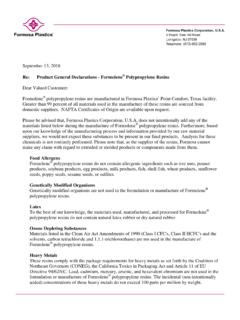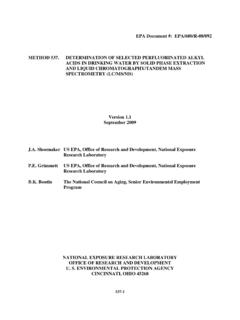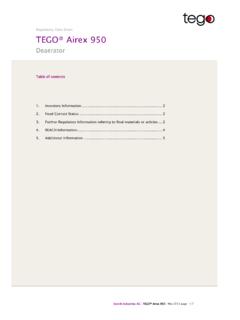Transcription of NICOLE Emerging Contaminants Working Group
1 Version January 2016 Page 1 PFASs Summary NICOLE Emerging Contaminants Working Group What are they? PFASs = Poly- and perfluoroalkyl substances Used since the 1950 s for a wide range of domestic and commercial applications, including surface coatings for carpets, soft-furnishings, paper, leather and metal, cleaning agents, and Class B fire-fighting foams (for flammable liquids). Domestic and commercial use of PFASs has led to widespread diffuse emissions ( from the breakdown of surface coatings). Point source emissions of PFASs may arise from landfills, large petrochemical facilities, urban wastewater treatment facilities and fire-fighting training facilities at airports, military bases, community fire services and large industrial facilities. Due to their unique physical and chemical properties, it is difficult to find equally effective replacement compounds for many applications.
2 Potential concerns Some PFASs have been identified as having bioaccumulative and toxic properties in humans and wildlife. One of them, perfluorooctane sulfonate (PFOS), was added in 2009 to the Stockholm Convention on Persistent Organic Pollutants. They tend to be mobile and persistent (no biodegradation) and migrate long distances in groundwater, surface water and air. Remedial options are still limited and expensive. Analytical methods are still being developed that can adequately evaluate related precursors and breakdown products which are an important consideration in assessment and remediation. Regulations: Regulatory focus regarding PFASs use, clean-up and protection of human health and the environment is steadily increasing. Several European countries have adopted drinking water guidelines and or soil and groundwater regulations for one or more PFASs compounds.
3 Recently the European Union adopted surface water environmental quality standards for PFOS. The annual average Environmental Quality Standard (EQS) for PFOS in inland surface waters is ng/L. This standard is extremely low and in many cases lower than background levels recorded in surface waters. This makes compliance following release of PFASs to the environment technically difficult. The European Union is considering strict regulations regarding perfluorooctanoic acid (PFOA) which may lead to an indirect ban of most PFASs-containing products. If you need to investigate the presence of PFASs in soil/groundwater, note the following issues: Sampling: While many commercial laboratories are able to analyse regulated PFAS substances to a detection limit of around 10 ng/L, few laboratories are able to analyse PFOS at the level required to meet the European EQS.
4 Analysis of PFOS to sub-ppt levels is difficult due to the risk of contamination from clothing and hygiene products used by sampler/analyst, sampling tools and laboratory equipment, notably PTFE bailers, vial caps and tubing. Analysis: The range of PFAS analysis available from commercial laboratories is limited and typically does not include PFAS precursor substances, which could lead to an underestimation of PFAS source strength. Total Oxidizable Precursors (TOP) analysis, which includes a sample pre-treatment step, can be used to screen for the presence of potential precursors. Risk assessment: fate and transport and toxicological data are available for PFOS and PFOA but scarcer for many other PFASs. PFASs biotransformation: numerous polyfluorinated precursors may bio-transform in the environment to form the more concerning persistent perfluorinated PFASs, notably PFOA; therefore, a product free of PFOS and PFOA may still lead to issues in the environment.
5 Local regulations: Applicable regulator limits for PFAS substances vary widely across the EU and are subject to regular update. Prevention of Future Releases: Consider switching to fluorine-free alternatives where possible. Consider capture and containment of PFAS-containing products before they reach the environment. Version January 2016 Page 2 PFASs Summary NICOLE Emerging Contaminants - PFASs summary - FAQs For further help: CONCAWE and NICOLE co-badged 2015 report summarizing the state of knowledge regarding PFASs Emerging Contaminants Fact Sheet PFOS and PFOA, US EPA, March 2014 Why is the EU EQS for PFOS so low? Is it relevant to my soil and groundwater issue? The annual average EQS for PFOS is based on secondary poisoning (humans eating fish) rather than ecotoxicity, due to the potential for PFOS to bio accumulate in the food chain.
6 The EQS incorporates a number of very conservative assumptions which new studies have identified may no longer be appropriate, (allocation of TDI, Bioconcentration Factor and Biomagnification factor) and may not be pertinent to the vast majority of locations (fish consumption rate). The EQS applies only to surface water and therefore is relevant to soil and groundwater issues only when surface water is expected to be a receptor in the context of the impacted site. Member states may set less stringent objectives within river basin management plans before the EQS needs to be met in 2027. I have found PFASs in groundwater and the risk assessment indicates remedial action is required. What are my current options? Remedial options for soil include excavation and off-site disposal or incineration, soil washing, stabilization and capping. For groundwater, the standard remedial technology is pump-and-treat with activated carbon or other commercial adsorbents, potentially with pre-treatment.
7 Some immobilisation agents are also being offered. Reverse osmosis and resins can also be used. Developing technologies include sonolysis and chemical oxidation. So far research has not identified any biodegradation pathways for perfluorinated PFASs. Are all PFASs Persistent Organic Pollutants (POP)? No, PFASs are not all POPs. PFOS is currently the only one listed in the Stockholm POP convention. However other long-chain (> C8) PFASs are suspected to have similar properties. Do I need to look at individual PFASs or the Total Oxidizable Precursors analysis? There are thousands of individual PFASs, each with different properties. Many products contain a mixture. Analytical methods and standards do not exist to identify all of them. Stakeholders may want to limit the analyses to regulated PFASs, and/or to key PFASs of particular concern for human health and the environment.
8 Given that precursors may biotransform into PFASs of concern, an overall measure of all PFASs precursors converted to readily analysable perfluorinated PFASs (TOP analysis) can also provide valuable information to evaluate management options. Therefore both analyses may be required. How do I sort out claims from vendors regarding environmentally friendly products? Long-chain (>C8) fluorotelomers advertised as replacement for PFOS and PFOA may still transform into PFOA in the subsurface. When possible, avoid products containing fluorinated surfactants or PFASs, and other highly persistent potentially toxic compounds. If no effective substitution is possible, consider high-purity short chain (<C6) PFASs as they cannot biotransform into PFOA or PFOS, however concern has been expressed about their use and their potential effects (Helsingorb and Madrid statements).











